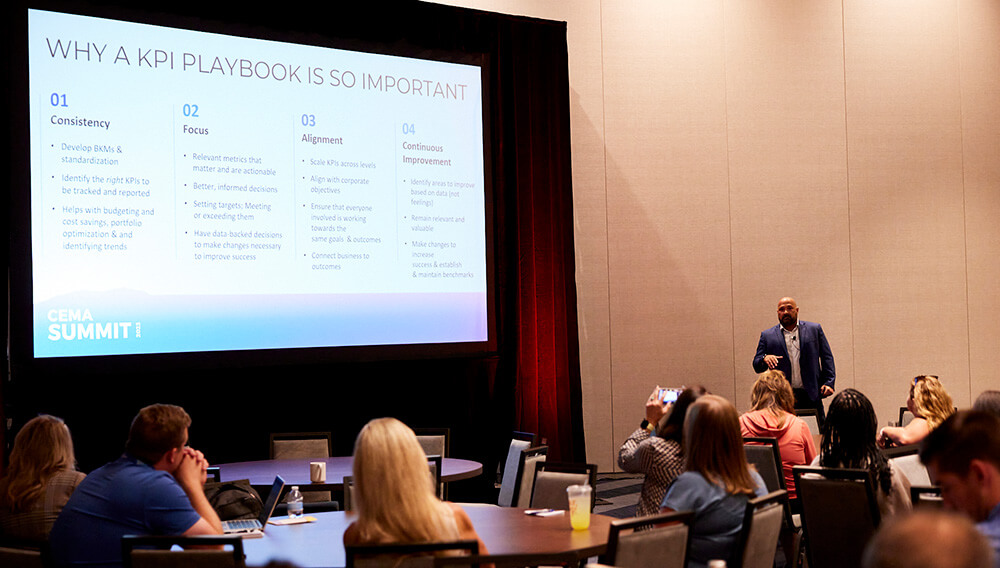
CEMA Summit participants color in the lines of a canvas at the Hyatt Regency Salt Lake City. They were encouraged to share who they are and where they are from.(Two Dudes Photography)
More than 500 corporate event marketers and their industry partners came together for CEMA Summit 2023, powered by PCMA, Aug. 6-8 in Salt Lake City, Utah, for a program designed to help them sharpen their strategy, analytics, and soft skills.
For the upcoming September/October issue, Convene editors summarized main takeaways from a handful of sessions to give you a sample of the knowledge exchanged during those three days. Online, we’re starting off the series with insights shared on how to determine your events’ KPIs, OKRs, and all the Rs (return on investment, experience, emotion, and objectives), with a bonus: Download an Event KPI Playbook template to get started.
CEMA session: ‘Success by the Book: How to Develop KPIs with Metrics that Matter’
In their CEMA session, Joe Federbush, president and chief strategist for EVOLIO Marketing, laid out how he and his client, Jon Wolff, global events manager for consumer electronics company Lenovo, put together a KPI playbook — an effective way for event marketers to capture and visualize data to communicate event results to peers and leadership. Here is what to consider when crafting this kind of framework.
Understand metrics lingo. What’s the difference between metrics vs. KPIs (key performance indicators) vs. OKRs (objectives and key results)? Federbush said that all KPIs are metrics, but not every metric is a KPI. “I think that’s where some people get confused,” he said. “Metrics are like data points for things that are important and they could be important to different people in different roles.”
OKRs, he said, are “next-level KPIs.” When you focus on OKRs, “you are looking at data over a period of time and how they progress towards meeting or exceeding your objectives,” Federbush said. “Next is the common data — the data that we’re all engulfed in every day. CRM data, registration data, lead data, meetings data, followed by attitudinal data.” This data is the output of qualitative and quantitative surveys. And then there is behavioral data — “what we are seeing a lot more of,” he said — which can be captured by cameras in face-to-face environments and measuring things like sentiment via social-media analysis.
Don’t overcomplicate things. “You’re probably looking at hundreds of data points,” Federbush said, but you need to “pluck the pieces out that are most important and those are your KPIs.” Creating a KPI playbook is important because it provides consistency, he said. “You then have buy-in from all the different departments and lines of businesses.” With a KPI playbook, of all the metrics and data points to consider, there is agreement that five or six will get captured, who is responsible for what, and how it gets reported.

Joe Federbush (right), president and chief strategist for EVOLIO Marketing, talks about how he and his client, Jon Wolff, global events manager for consumer electronics company Lenovo, put together a KPI playbook. (Two Dudes Photo)
Focus on measuring what matters. “If it’s not actionable, if you can’t make truly informed decisions from it,” Federbush asked, “then why are you capturing it?” He shared the example of a medical event marketer that used a “bogus” metric: How many coffee cups were used by attendees who visited the company’s coffee bar at their convention booth. “What kind of informed decisions are you going to make from that?” he asked. Make sure that your objectives, your KPIs, are all aligned across the board, he said, and that they could scale, are relevant to different business units, and tie back to outcomes.
It’s about continuous improvement. It’s particularly important today to ensure that we’re continuously improving, “from the keynote to the last session,” Federbush said. “You have to be proving return on lots of things, return on investment, return on emotion, return on experience, return on objectives.” When creating your playbook, clearly define your objectives. “Get feedback and input from stakeholders,” he said. “Don’t just look at it as event marketing in a vacuum. Talk to executives, talk to procurement, talk to sales, talk to different lines of businesses. How do they define success?” Understanding everyone’s objectives will help you in collecting the right data and be clear on who’s responsible for capturing what, Federbush said, because the data sources are coming from all over the place.
Consider demand gen vs. ROI. “ROI can be a little nebulous,” Federbush said. “ROI can mean a lot of things to a lot of people. And frankly, depending on what you do and what your buying cycles are, ROI is impossible to track.” From a KPI and objectives standpoint, he said, it’s more important to focus on demand gen — “whether by putting this event on or exhibiting in these shows or sponsoring this or that, are we creating demand for our products? It doesn’t mean buying, it just means are people more interested in buying or learning more.” Examples of KPIs that fall under demand gen “could be things like attributable revenue to that metric,” he said. “It’s unrealistic in most cases to say, ‘Oh, they came to our event or they came to my booth and then they bought the next day and they never heard of us before.’ They were nowhere in the purchasing funnel. It’s unrealistic to say that event ROI is so black and white.”
Pay attention to the touchpoints. “We have meetings at events with key customers and prospects and press and analysts,” Federbush said. “What were the outcomes of those meetings? Did they move that contact through the pipeline? Did they accelerate the pipeline? Leads can be broken down into marketing qualified leads (MQLs) vs. sales qualified leads (SQLs) and entered into your CRM or marketing automation databases, he said. You really should be tracking and thinking of your leads as marketing leads, not just sales.
Key account connections and brand impact. Identify your key accounts — “the people we really want to make sure that you’re extending those relationships with vs. ‘Like, wow, there’s 20,000 people at our event,’” Federbush said. Brand impact is another important objective for corporate event marketers. “We can control brand impact way more than we can control demand gen because we’re marketers, we’re in charge of the event,” he said. This involves consistent messaging, net promoter scores, changing brand perceptions, familiarity with the brand, sentiment about that brand. “Brand impact metrics typically are going to require a survey,” he said, “or some sort of attendee or visitor feedback to understand how they feel or how they agree with really important marketing messages, followed by engagement.”
Speaking of engagement. Now that we’re back to meeting in-person, Federbush added, we can’t be lazy about engagement. “We have to like reset, reboot, rethink — re-everything — about the way we are engaging with our customers and prospects and even seeing what the competitors are up to.”
Download the EVOLIO Marketing’s Event KPI Playbook template.
‘Terrible at Understanding’ Data

Jon Wolff
During the Q&A part of the session, one audience member said, “We’re really good at gathering things and terrible at understanding what they mean and actually leveraging them afterwards. There’s a new tool every week that claims to solve this problem, but internally, there aren’t really the resources or the strategy in place to actually leverage a new tool. So we end up with a spend and in the same place we were a year ago — except now we have more data, but know even less about what it means or what it’s supposed to be telling us about what our strategy is moving forward.” If you had to give one piece of advice to an organization that was in that position, she asked, what would it be?
While Lenovo’s Jon Wolff didn’t have a silver bullet for her situation, he stressed that overcommunication on how he and his team performed at each event in terms of the agreed-upon metrics was key for him. “It’s a discussion with the broader team. It’s communication with the executives. It’s making sure that they know,” he said, that “we’re not just doing this, we’re doing this — plus, this is how we are influencing [outcomes] and what are the next steps.”
Michelle Russell is editor in chief of Convene.
